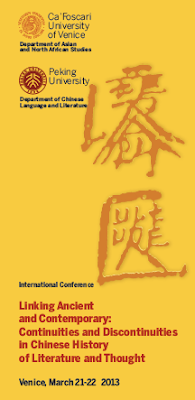The Dipartimento di Studi sull'Asia esull'Africa Mediterranea (DSAAM) of the Università Ca'Foscari Venezia, in
collaboration with the Department of Chinese Language and Literature of 北京大学 Peking
University, organised an international conference in Venice from 21-22 March
2013 on the subject of "Linking Ancient and Contemporary:Continuities and Discontinuities in Chinese History of Literature andThought".
Sean Golden, a member of the Inter-Asia research Group, spoke at the conference on the subject of “Liu Xie 劉勰’s Wénxīn Diāolóng 文心雕龙, Ernest Fenollosa’s complete The Chinese Written Character as a Medium for Poetry and 20th century avant garde American writing outside the Ezra Pound tradition”.
Sean Golden, a member of the Inter-Asia research Group, spoke at the conference on the subject of “Liu Xie 劉勰’s Wénxīn Diāolóng 文心雕龙, Ernest Fenollosa’s complete The Chinese Written Character as a Medium for Poetry and 20th century avant garde American writing outside the Ezra Pound tradition”.
Abstract
Ezra Pound’s edition of Ernest Fenollosa’s
manuscripts for The Chinese Written Character as a Medium for Poetry was a
landmark in modernist European poetry and the imagist movement at the beginning
of the 20th century. Pound’s work has stood for Fenollosa’s vision since then
and has been the subject of controversy among Sinologist’s for its emphasis on
the graphic elements of Chinese written characters. A recent edition of the
complete Fenollosa manuscripts by Haun Saussy, Jonathan Stalling and Lucas
Klein has made it possible to see the differences between Fenollosa’s interests
and Pound’s interpretations and to restore Fenollosa’s original intentions.
Even though Sinologists have questioned the Fenollosa-Pound emphasis on the
graphic elements of Chinese writing as a component part of Chinese poetry,
Chapter 39 of the classical Chinese text
文心雕龙 Wénxīn
diāolóng by 劉勰 Liu Xie (ca. 466-ca. 520) refers specifically to this phenomenon as
a mode in the composition of Chinese poetry. Case studies of work by John Cage
and Jackson Mac Low show that Fenollosa’s impact on 20th century avant garde
literature went far beyond the works of Ezra Pound.


Cap comentari:
Publica un comentari a l'entrada